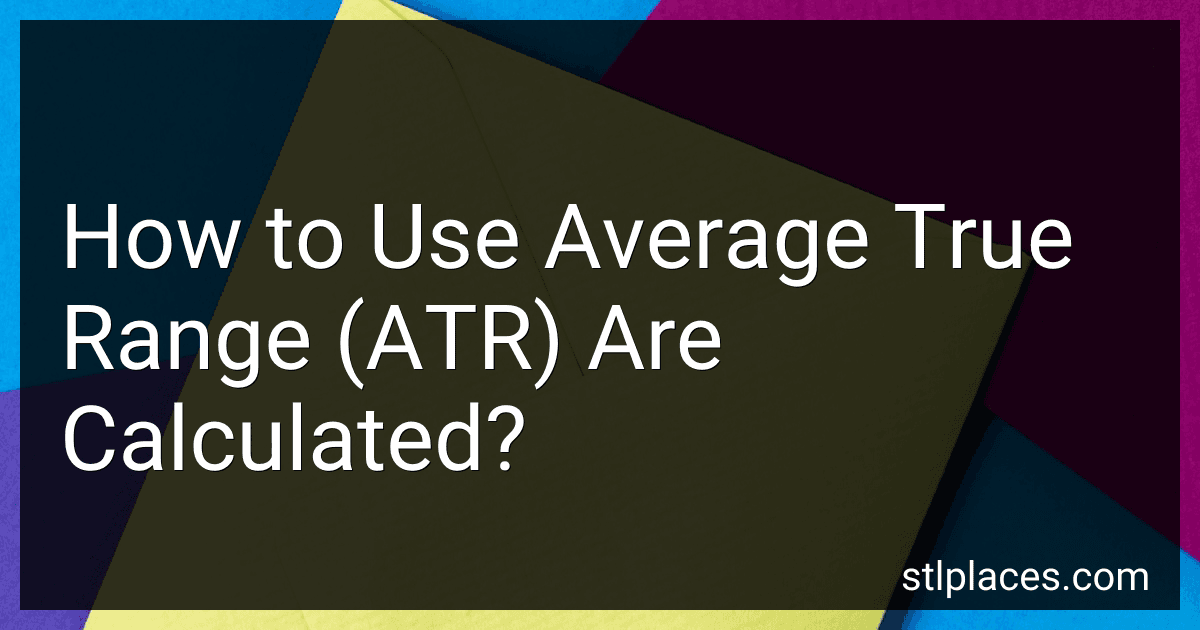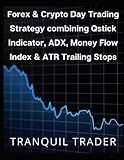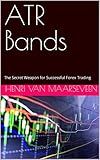Best ATR Calculation Tools to Buy in December 2025
Average True Range (ATR) is a technical indicator used in financial markets to measure market volatility. It helps traders and investors gauge the level of price fluctuation in a particular asset, which is valuable information for various trading strategies and risk management.
To calculate the Average True Range, the following steps are involved:
- Calculate the True Range (TR) for each period: The true range is the maximum value of three calculations: a. Current high minus current low b. Absolute value of the current high minus the previous close c. Absolute value of the current low minus the previous close Determine the true range by taking the highest value among these three calculations.
- Determine the period value: Choose a specific period for which you want to calculate the Average True Range. Most commonly, a 14-period ATR is used, but you can customize it based on your trading preferences.
- Calculate the initial value: To start calculating the Average True Range, take the sum of the true range values for the selected period and divide it by the chosen period.
- Calculate subsequent values: From the second period onward, utilize the previous ATR value and true range of the current period to recalculate the ATR. Use the following formula: a. Multiply the previous ATR value by the period minus one. b. Add the true range of the current period. c. Divide the sum by the selected period. The obtained value will be the updated ATR.
By repeating steps 4 for each subsequent period while using the updated ATR to calculate the new value, you can establish an ongoing Average True Range for the asset.
Remember that ATR doesn't provide information about the direction of the market, only the magnitude of price movement. Therefore, it is often used alongside other technical indicators to make informed trading decisions. Traders may utilize ATR to set stop-loss levels, identify potential trend changes, or assess the risk and reward levels of a trade.
How to use ATR to assess risk-reward ratios?
To use the Average True Range (ATR) indicator to assess risk-reward ratios, follow these steps:
- Understand the ATR indicator: ATR measures market volatility by analyzing the range between a series of high and low prices. It provides a sense of how much an asset's price typically moves within a given timeframe.
- Identify the ATR value: Calculate the ATR value for the desired timeframe (e.g., 14 days) using the following formula: Calculate the True Range (TR), which is the largest value among: Current high minus the current low Absolute value of the current high minus the previous close Absolute value of the current low minus the previous close Repeat this calculation for the desired number of periods (e.g., 14 days) and find the average of the TR values to obtain the ATR value.
- Determine your risk tolerance: Establish the maximum percentage of your trading account that you are willing to risk on a single trade. This is typically a personal decision based on your risk appetite.
- Set your stop-loss level: Multiply the ATR value by a factor you deem appropriate based on your risk tolerance. For example, if your risk tolerance is 2% of your account, multiply the ATR by 0.02 to determine the dollar amount you are willing to risk.
- Calculate potential reward: Identify a suitable target price or profit level based on your trading strategy. This could be determined by technical analysis, support/resistance levels, or other indicators.
- Assess the risk-reward ratio: Compare the amount you are willing to risk (stop-loss level) to the potential reward (target price). Calculate the ratio by dividing the potential reward by the amount at risk. For example, if your potential reward is $200 and you are risking $100, the risk-reward ratio would be 2:1.
By utilizing the ATR indicator and applying your risk tolerance, stop-loss level, and profit target, you can assess the risk-reward ratio for a trade. This information can help you evaluate whether a trade opportunity presents a favorable risk-reward balance, helping you make more informed decisions.
What is the significance of ATR in determining position sizing?
The Average True Range (ATR) is a technical indicator that measures the volatility of a security. It provides traders and investors with insight into the potential price movement of an asset. When it comes to determining position sizing, ATR can be used to fine-tune the number of shares or contracts to be traded.
Here are a few key aspects of the significance of ATR in position sizing:
- Volatility measurement: ATR reflects the magnitude of price fluctuations in a security. It gives a measure of the market's volatility, indicating how much an asset's price typically moves. By considering the ATR, traders can better assess the potential risk and reward associated with a trade.
- Risk management: Position sizing is a crucial aspect of risk management. ATR helps traders determine an appropriate position size based on their risk tolerance. Higher ATR values imply greater potential price swings, which may necessitate smaller positions to manage risk effectively. Conversely, lower ATR values may allow for larger positions, as the security is expected to have less significant price movements.
- Stop loss placement: ATR can assist traders in setting appropriate stop-loss levels. Since ATR provides an understanding of the typical price range, it can be used to determine the distance at which a stop-loss order should be placed. By setting stop-loss levels based on ATR, traders aim to ensure that their trades are not prematurely exited due to normal market fluctuations but are protected against excessive losses if price movement exceeds the average range.
- Position scaling: ATR values can be utilized to dynamically adjust position sizes based on market conditions. As ATR rises or falls, position sizes can be adjusted accordingly. This approach allows traders to adapt their position sizes to changes in market volatility in order to maintain consistent risk exposure.
Overall, ATR is a valuable indicator that aids traders in determining position sizing by providing insights into market volatility, managing risk, setting stop loss levels, and adjusting positions based on changing market conditions.
How to use ATR to determine potential breakouts?
The Average True Range (ATR) is a useful technical analysis indicator that can help traders identify potential breakouts. Here's a step-by-step guide on how to use ATR to determine potential breakouts:
- Calculate the ATR: Start by calculating the ATR value using a specific time period. The most common period used is 14 days, but you can adjust it according to your trading style and preference. ATR measures price volatility, so it indicates the range in which the price has been moving over the specified period.
- Identify compression: Look for a period of low volatility or compression in the ATR value. This signifies a period where the market is consolidating or ranging, with limited price movement.
- Monitor price action: While the market is in a state of low volatility, closely monitor price action for signs of a potential breakout. Pay attention to price patterns like triangles, consolidations, or channels, which often precede breakouts.
- Determine breakout level: Once you have identified a compression phase and a potential price pattern, determine the breakout level. This level is usually marked at the point where the price breaks above or below the consolidation or pattern.
- Confirm with ATR expansion: To increase the reliability of a potential breakout, wait for an expansion in the ATR. An expansion indicates the return of volatility, which often accompanies breakouts.
- Place trades accordingly: Once the price breaks out of the consolidation pattern and the ATR expands, consider entering a trade in the direction of the breakout. Ensure you have appropriate risk management strategies in place, such as setting stop-loss levels and target profits.
Remember, like any indicator, the ATR is not foolproof and should be used in conjunction with other technical analysis tools and indicators to confirm potential breakouts. Additionally, it is crucial to practice risk management and avoid relying solely on any single indicator for trading decisions.
What is the purpose of using ATR in trading?
The Average True Range (ATR) is a technical indicator used in trading to measure market volatility. Its purpose is to provide traders with information about the level of price volatility in a particular market or security over a given period of time. By understanding market volatility, traders can make informed decisions regarding their trading strategy, risk management, and position sizing.
ATR is particularly useful in setting stop-loss levels and determining potential profit targets. A higher ATR value indicates greater volatility, meaning that the price of an asset can move by larger amounts over a given period. Traders may choose to set wider stop-loss levels to account for higher potential price fluctuations or adjust their profit targets accordingly. On the other hand, a lower ATR value suggests lower volatility, allowing traders to set tighter stop-loss levels or adjust profit targets accordingly.
By incorporating ATR into trading strategies, traders can better manage their risks and adapt their approach to accommodate the varying levels of volatility that exist in the market.
How to interpret Average True Range values?
The Average True Range (ATR) is used to measure the volatility of an asset or security. It provides an indication of the average range at which the price is fluctuating over a given period of time. Here's how to interpret ATR values:
- Higher ATR values indicate higher volatility: When the ATR value is higher, it suggests that the price swings are wider, meaning there is more volatility in the market. Traders and investors should be cautious and adjust their trading strategies accordingly. It may be advisable to use wider stop-loss orders or trade smaller positions to accommodate for increased volatility.
- Lower ATR values indicate lower volatility: Conversely, when the ATR value is lower, it suggests that the asset or security is experiencing less price movement or volatility. This might indicate a period of consolidation or stability in the market. Traders might consider tightening their stop-loss orders or look for other opportunities with higher volatility if they prefer more active trading.
- ATR can help in setting stop-loss and take-profit levels: Traders often use ATR to determine appropriate levels for setting stop-loss and take-profit orders. By using multiples of the ATR, such as 1x or 2x, traders can set their stop-loss orders below or above recent price swings, taking into account the asset's volatility. This allows for more realistic expectations of price movements and reduces the chance of prematurely closing a trade.
- ATR can be used for position sizing: Traders can also utilize ATR values to determine the appropriate position size for a trade. By considering the average range of price movement, traders can adjust their position size to ensure they are not risking too much capital based on the current volatility of the asset.
It is important to note that ATR is a relative measure of volatility and should not be interpreted in isolation. It should be used in conjunction with other technical analysis tools and indicators to gain a comprehensive understanding of the market conditions and make informed trading decisions.
What factors are considered when calculating ATR?
The Average True Range (ATR) is a technical indicator used to measure volatility in the price of a financial instrument. It is calculated based on a range of factors, including:
- Price range: The difference between the high and low prices of a given period. It represents the overall price movement during that period.
- True Range: The true range is the greatest of the following three values: a. Current high minus the current low b. Absolute value of the current high minus the previous close c. Absolute value of the current low minus the previous close
- Number of periods: ATR is calculated over a specific period of time, typically 14 periods as a default, but this value can be adjusted based on trader preferences or strategies.
- Moving Average: ATR is usually calculated as an exponential moving average (EMA) of the true range over the selected number of periods. This helps smooth out fluctuations and provides a more consistent measure of volatility.
Considering these factors, the ATR is calculated by taking the average of the true range over the specified period, using an exponential moving average formula. The resulting value represents an average volatility level over that period, helping traders gauge potential price movements and adjust their trading strategies accordingly.
How is the ATR calculated for financial markets?
The Average True Range (ATR) is a technical indicator used to measure market volatility. It was developed by J. Welles Wilder Jr. and is commonly used by traders and analysts to assess price volatility and set stop-loss levels for trades.
The ATR is calculated using a series of calculations based on the true range (TR) of an asset. The true range is the greatest of the following three values:
- High minus the low of the current period.
- Absolute value of the high minus the previous close.
- Absolute value of the low minus the previous close.
Once the true range is calculated for each period, the average true range is derived by finding the average of these true range values over a specified period.
Here is the step-by-step process to calculate ATR:
- Determine the true range (TR) for each period using the above formula.
- Choose a specific period (e.g., 14 days) to calculate the ATR.
- Sum up the true range values for the specified period.
- Divide the sum by the chosen period to get the average true range.
For example, if you calculate the true range values for the past 14 days, you would sum up these values and divide by 14 to obtain the average true range for that period. Traders often use different timeframes and periods depending on their trading strategies and preferences.
The resulting ATR value can be used to identify periods of high or low volatility. Higher ATR values indicate greater volatility, while lower values suggest lower volatility. Traders can employ the ATR in conjunction with other technical indicators to make informed decisions about entry and exit points, as well as position sizing.




